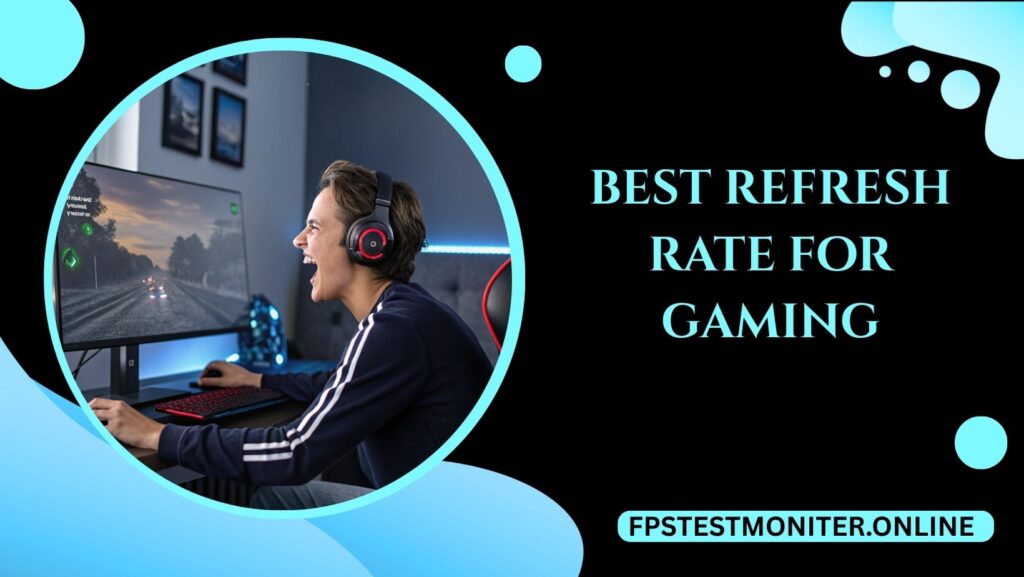
When it comes to gaming, refresh rate is one of the key factors that affects how smooth and responsive your gameplay feels. Choosing the right refresh rate depends on the type of games you play, your hardware, and even your personal preferences.
This article explains what refresh rate is, how it impacts gaming, and provides practical advice on what refresh rate to aim for based on different gaming needs.
What Is Refresh Rate?

Refresh rate refers to how many times per second a display updates the image on the screen, measured in hertz (Hz). For example, a 60 Hz monitor refreshes the picture 60 times per second. This refresh speed directly influences how fluid motion looks during games and how responsive your controls feel.
The higher the refresh rate, the smoother moving objects will appear. Especially in fast-paced games, this can make a noticeable difference in both experience and performance.
Why Refresh Rate Matters In Gaming
In gaming, every millisecond counts. A higher refresh rate offers two primary benefits:
- Smoother visuals: Motion appears clearer and less blurry at higher refresh rates.
- Lower input lag: Your actions, like moving the mouse or pressing a key, register faster on screen, which matters greatly in competitive gaming.
Most standard monitors come with 60 Hz, which is generally fine for casual gaming and slower-paced titles. But for gamers interested in competitive shooters, racing, or other fast action games, higher refresh rates can give a real advantage.
Common Refresh Rates Explained
There are several common refresh rate options available on the market:
- 60 Hz: Standard for most displays. Good for general use and casual gaming.
- 75 Hz to 90 Hz: Offers slight improvement in fluidity, often found on budget gaming monitors.
- 120 Hz: A noticeable upgrade from 60 Hz, supports smoother gameplay and is often seen in gaming consoles like Xbox Series X.
- 144 Hz: Popular among competitive gamers for fast-paced and online multiplayer games.
- 165 Hz: Slight step above 144 Hz with certain gaming monitors, but the difference is less perceptible to most users.
- 240 Hz and above: Top-tier refresh rates mostly used in professional esports or by serious enthusiasts.
Choosing The Refresh Rate Based On Game Type
The ideal refresh rate depends on what kind of games you play:
Casual or Story-Driven Games
If you primarily play single-player RPGs, strategy games, or slower-paced titles, a 60 Hz or 75 Hz refresh rate usually meets your needs. These games don’t rely on lightning-fast reaction times, so the difference in smoothness won’t be critical.
Fast-Paced Competitive Games
For first-person shooters (FPS), battle royale games, and racing simulators, aim for at least 120 Hz. Many professional gamers prefer 144 Hz or higher because smoother frames mean better precision and timing.
Esports and High-End Gaming
If you are an esports competitor or want the absolute best for fast reaction titles, 240 Hz or more monitors are worth considering. These displays offer nearly instant feedback and ultra-smooth motion, but they require powerful graphics cards to maintain high frame rates.
How Your Hardware Affects Refresh Rate Performance
Refresh rate doesn’t work in isolation. Your computer’s GPU must be capable of rendering frames at a speed that matches the monitor’s refresh rate to take full advantage.
For example:
- A 144 Hz monitor is best paired with a GPU that can deliver close to 144 frames per second (fps).
- If your GPU outputs only 60 fps, the rest of the frames won’t be visible, making a higher refresh rate less beneficial.
Make sure your system’s processor and GPU are balanced and able to sustain frame rates that align with your chosen refresh rate.
Adaptive Sync Technologies
Modern gaming monitors often include adaptive sync technologies like NVIDIA G-SYNC or AMD FreeSync. These features synchronize the monitor’s refresh rate with the GPU’s output to reduce screen tearing and stuttering for a smoother experience, especially when frame rates fluctuate.
If your GPU supports these technologies, pairing it with a compatible monitor can enhance smoothness more effectively than just increasing the refresh rate alone.
What To Consider Along With Refresh Rate
While refresh rate is important, other display factors contribute to the overall gaming experience:
- Response time: The speed with which a pixel changes color affects motion clarity. Lower response times (1-5 ms) are preferable for gaming.
- Resolution: Higher refresh rates at 1080p are easier to achieve than at 4K, where frame rates tend to be lower.
- Panel type: TN panels offer faster response but poorer color accuracy. IPS panels provide better colors but sometimes slightly slower response.
Balance these variables based on your priorities and budget.
Practical Advice for Choosing Your Monitor
- Start by deciding your target refresh rate based on your main game genres and skill level.
- Check whether your PC or console can consistently deliver frame rates that match or exceed your chosen refresh rate.
- Consider monitors with adaptive sync to reduce visual artifacts.
- Don’t overlook screen size and resolution alongside refresh rate for a balanced setup.
- Try to test the monitor if possible before buying to evaluate the real-world smoothness and input lag.
How Many Hz Can the Human Eye See?
Explore the science of vision and refresh rates for gaming displays.
Frame Rate vs Refresh Rate
Understand the difference and why both matter for smooth visuals.
How Much Does the CPU Affect the FPS?
Explore how CPU performance can influence gaming frame rates.
Is FreeSync Worth It?
A guide on FreeSync technology and whether it’s worth it for your setup.
How to Make Fortnite Faster on PC
Practical tips to boost FPS and smooth gameplay on your computer.
🔹 Final Thoughts: Finding the Right Refresh Rate
The best refresh rate for gaming depends on your setup and playstyle. Casual players often find 60–75 Hz smooth enough, while competitive gamers thrive at 120 Hz and beyond—with 144 Hz offering a great balance. Esports professionals may push to 240 Hz or higher for the fastest response times.
Remember, refresh rate is just one part of the gaming experience. Your GPU, monitor, and personal comfort all play a role in what feels “smooth” and responsive.
In the end, the right refresh rate is the one that matches both your system and your needs. Balance performance, visuals, and budget to get the most out of your games.
Frequently Asked Questions
What is Refresh Rate
For most casual and mid-level gamers, 60 Hz to 75 Hz provides a good experience. It’s suitable for a wide variety of games without requiring high-end hardware.
Q2? Can I use a 144 Hz monitor with a console?
Yes, many modern consoles like the Xbox Series X support refresh rates up to 120 Hz. However, not all games run at that speed, so verify game compatibility before investing.
Q3? Does increasing refresh rate always improve gameplay?
Higher refresh rate improves smoothness and reaction time only if your system can maintain matching frame rates. Without capable hardware, the visual benefits will be limited.
Q4? Is 240 Hz worth it for non-professional gamers?
For casual players, the difference between 144 Hz and 240 Hz is often subtle. Unless you are into competitive esports, investing in 240 Hz may not be necessary.
Q5? How important is response time compared to refresh rate?
Both matter. A fast refresh rate delivers smooth frames, while a low response time reduces motion blur. Ideally, choose a monitor that balances both for the best gaming experience.
